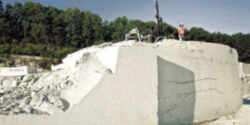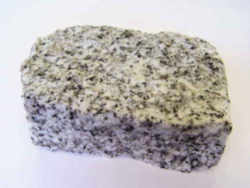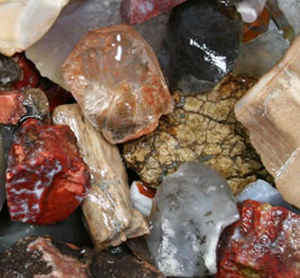
North Carolina Symbols
North Carolina State Rock
Granite

Adopted in 1979.
The General Assembly of 1979 designated Granite as the official Rock for the State of North Carolina. (Session Laws, 1979, c. 906).
The State of North Carolina has been blessed with an abundant source of "the noble rock," granite. Just outside Mount Airy in Surry County is the
largest open face granite quarry in the world measuring one mile long and 1,800 feet in width. The granite from this quarry is unblemished, gleaming,
and without interfering seams to mar its splendor. The high quality of this granite allows its widespread use as a building material, in both industrial
and laboratory applications where supersmooth surfaces are necessary.
North Carolina granite has been used for many magnificent edificies of government throughout the United States such as the Wright Brothers Memorial
at Kitty Hawk, the gold depository at Fort Knox, the Arlington Memorial Bridge and numerous courthouses throughout the land. Granite is a symbol of
strength and steadfastness, qualities characteristic of North Carolinians. It is fitting and just that the State recognize the contribution of granite
in providing employment to its citizens and enhancing the beauty of its public buildings.
Among the most popular, the hardest, and the oldest of geosymbols, granite is an official symbol of New Hampshire, Massachusetts, North Carolina, South Carolina, Vermont, and Wisconsin.
North Carolina State Rock: Granite

Mount Airy, nicknamed "The Granite City,"is home to the largest open face granite quarry in the world. On the surface alone, the quarry encompasses about 60 acres, or roughly the equivalent of 66 football fields. Mount Airy lore maintains that astronauts spotted The Rock from space as they orbited the Earth. That's how large this rock is, and that's just the part you can see. The mother mass - the block you can't see - is about 7 miles long and 1 mile wide, north and south. And it's 8,000 feet deep. There are larger pit quarries throughout the world but no larger open face quarries. Visit the observation deck, where you can see nearly all the activities and are close enough to be plenty startled when we set off an explosion, which occurs several times each day. The observation deck can be reached by car, and access is open without restriction each day that the quarry is in operation, including weekends, during the daylight hours.
About 336 million years, to be precise. It was then that The Rock formed through a geological process called plate tectonics.
"Our planet is a restless planet,"says Bert Meijboom, a Pilot Mountain geologist who does consulting work for the North Carolina Granite Corp. and is familiar with the granite quarry. "Continental plates are constantly on the move."
North Carolina sits on the North American plate, Meijboom says. Several times in geological history - remember, we're talking about millions of years here - that plate has collided with the African Plate. The last time it happened - approximately 360 million years ago - portions of the African plate subsided beneath the North American plate, creating a subduction zone that set the stage for the formation of Mount Airy's huge granite quarry.
"It was along such a zone, some 12 to 25 miles underneath the American plate, that blobs of molten rock were formed,"Meijboom says. "Due to its relatively lighter weight, the molten rock, also called magma, started to rise toward the surface, intruding the upper portions of the plate."
The magma slowly solidified over millions of years and formed what's known as a pluton - basically, a body of igneous rock that develops beneath the earth's surface. As the plates continued to move and extensive erosion occurred, these plutons - one of which geologists actually refer to as the Mount Airy pluton - appeared at the surface, giving The Rock its designation as an open-faced quarry.
The Rock - GRANITE

Granite is a light-colored igneous rock with grains large enough to be visible with the unaided eye. It forms from the slow crystallization of magma below Earth's surface. Granite is composed mainly of quartz and feldspar with minor amounts of mica, amphiboles and other minerals. This mineral composition usually gives granite a red, pink, gray or white color with dark mineral grains visible throughout the rock.
- Igneous Rock Type: Intrusive
- Related to: Rhyolite, pegmatite, syenite
- Chemistry: Acidic
- Color: White, pink, orange, gray, black
- Texture: Phaneritic (easy to see crystals)
- Origins: Orogenic Plutons
- Common Minerals: Quartz, feldspars, hornblende and micas
- Accessory Minerals: Tourmaline, phosphates, rare earth oxides, beryl, topaz, zircons, augite, sphene and apatite
- Uses: Building material, decorative counter tops, tiles, tombstones, roads, jewelry, curling stones, marbles
North Carolina Law
The law designating granite as the official North Carolina state rock is found in the North Carolina General Statutes, Chapter 145 Section 145-10.
Chapter 145: State Symbols and Other Official Adoptions.
§ 145-10. State rock. Granite is adopted as the official State rock of the State of North Carolina. (1979, c. 906, s. 1.)
Minerals, & Gems

Gemstone, Minerals, Rocks






